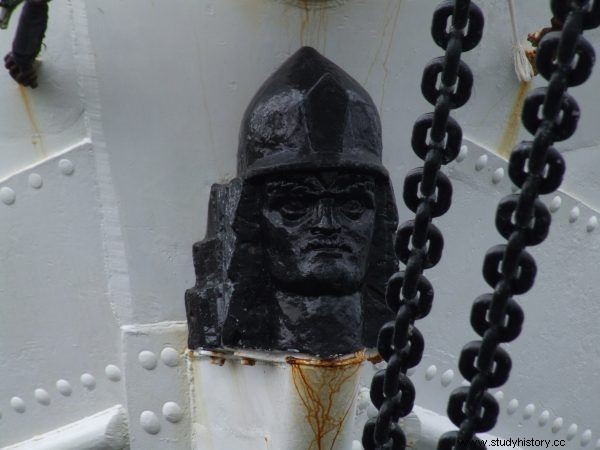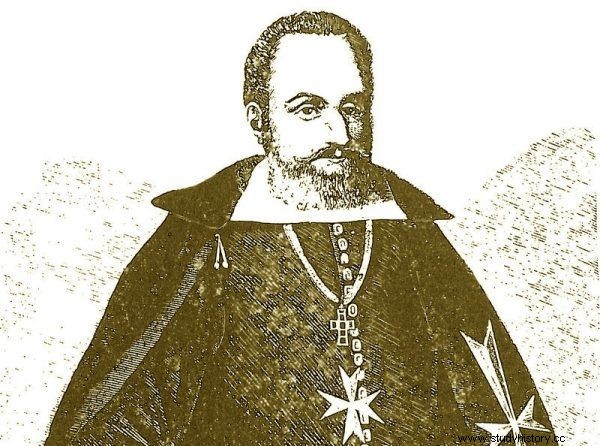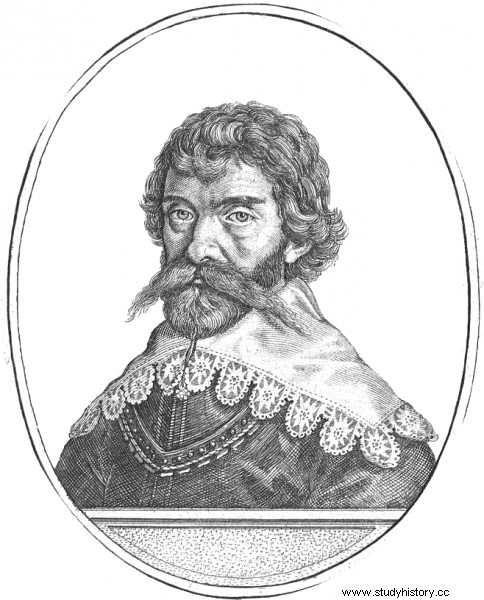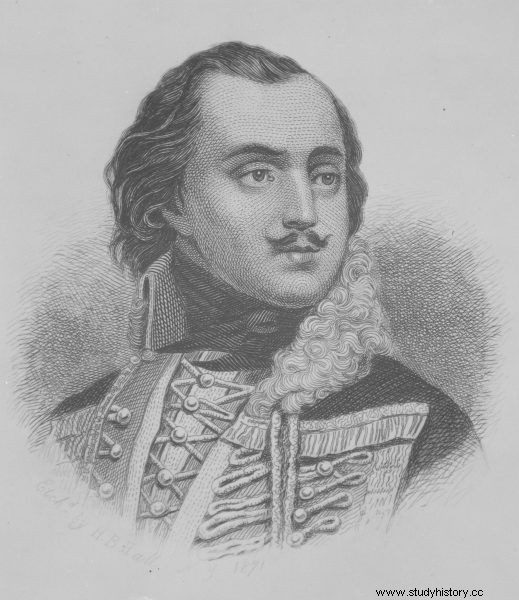A round sum from the German emperor. Expedition with or against the King of France. Depending on who pays better. Fortune from Hungarians and pocket money from Moravians. The best Polish warriors fought for money. And they weren't ashamed of it at all.
Zawisza Czarny
The most famous Polish medieval knight spent a large part of his military career under foreign banners. He started in the branches of Margrave Procopius of Luxembourg. Little is known about this stage in Zawisza's life. All in all, there was nothing to brag about, because Prokop was a typical feudal adventurer, fighting for power at the head of a gang of soldiers. This group included Zawisza Czarny. In 1399, together with others, he occupied the property of the Olomouc bishop, for which he was threatened with a curse.
When Prokop ended up in prison, Zawisza changed his employer. This time he enlisted in the service of the Hungarian king Sigismund of Luxembourg. At that time, many Polish knights decided to fight in the armies of this ruler. "They were attracted to Hungary not only by the hope of a chivalrous adventure, but most of all by the desire to improve their property status," wrote Beata Możejko, Sobiesław Szybkowski and Błażej Śliwiński, authors of Zawisza's biography.

Zawisza Czarny fought for Zygmunt Luksemburski, among others. The photo shows the image of Zawisza placed on the yacht of his name.
Zawisza has undoubtedly achieved this goal. As Marcin Szymaniak writes in his book Fighterzy. The best Polish warriors ":
While serving Sigismund, the most famous Polish knight took part mainly in battles with the armed opposition supporting rival candidates for the Hungarian throne. He still stood out, and Zygmunt rewarded him generously. The black-haired warrior (...) received i.a. right to collect income from the town of Sabinov in Upper Hungary (now Slovakia). As a proven mercenary, he also enlisted his younger brother, Jan Farurej, to serve the King of Hungary. .
A Polish knight, fighting for Zygmunt's money, had the opportunity to fight in Bosnia in 1408 or with the Hussites in 1422. In 1428 he found himself in the army of the Hungarian king, who was going to fight the Turks. An ideology was added to it (what a noble Zawisza:this is, after all, a fight against the enemies of Christianity!), But the biographers quoted above have no illusions. "We reduce a thing to a material dimension," they conclude.
It was during this expedition, specifically near Golubec in today's Serbia, that the Grim Reaper caught the most famous Polish knight. According to the preserved account, he was taken prisoner by the Turks, but two Janissaries argued about a valuable prisoner and during an argument one of them chopped Zawisza's head off.
Bartłomiej Nowodworski
Today his name is associated with the Krakow high school, but Bartłomiej Nowodworski was once the best specialist in explosions in the Republic of Poland. Thanks to him, in 1611 the gates of Smolensk were opened to the Polish army (although it would be better to say that they flew into the air), and in 1618 it was not so much that the capture of Moscow would also decorate Mr. Nowodworski's military CV. Unfortunately, poor coordination of actions, betrayal of some soldiers and, finally, a heavy wound that he sustained during the fighting decided about the failure of the Polish assault on the Russian capital.
Mr. Bartholomew's earlier biography, however, did not look as crystal-clear. In 1582, he killed in a duel Biedrzycki, King Stefan Batory's peace-keeping. He was threatened with the death penalty, so he escaped. He fled to the court of Henry III, King of France. He was also the former king of Poland, known here as Henryk Walezy.

Today he is mainly associated as the patron of the Krakow high school, in his era Bartłomiej Nowodworski was considered a specialist in explosions.
The monarch had rather poor memories of his stay on the Vistula, but he was able to appreciate the brave soldiers. And since a civil war was in full swing in France, Mr. Bartholomew found a job, although it was not an easy piece of bread. Marcin Szymaniak describes his exploits abroad as follows:
Nowodworski took part in the attack on Pontoise, a stronghold controlled by ligers. He was hit in the shin with an arquebus bullet, but he had already shown himself to be brave. The city fell, Pole received personal praise and award from Henry III .
The Polish nobleman turned out to be a truly universal man. First he fought in the army of Henry III against the Catholic League, then in the Catholic League against another king - Henry IV, and finally in the service of Henry IV again against the League. As a French mercenary, he spent seventeen years of his life at Nowodworski, later became a Knight of Malta, and finally returned to his homeland and wrote down the pages of his biography in golden letters.

Czarniecki is a Lisowczyk? Picture by Brodero Matthisen, 1659.
Stefan Czarniecki
The only hetman to be included in the national anthem began his career in the ranks of the Lisowczyk family. It was a light cavalry, which in 1619 was paid by Emperor Ferdinand II. Equally dangerous to enemies as to civilians - in comparison with them the Kmicic company from Sienkiewicz's "Deluge" ... There is nothing to compare here.
To put it bluntly:one of the most famous Polish commanders took his first steps fighting for Austrian money with the emperor's enemies. The famous diarist Jan Chryzostom Pasek recalled that "He was looking for her [i.e. of death] from his young years in the Czech provinces, in German provinces, with his brother, the banner. "
Little is known about this period in Czarniecki's life. As Adam Kersten, the author of the great biography of the hetman, wrote, “Lisów's past was eagerly concealed by the Lisów people themselves. People repeatedly sentenced to banishment and infamy, if they could obliterate the memory of it, they did it eagerly. "
The experience gained from mercenary years paid off in the future. For Czarniecki it was an excellent school of military craftsmanship, which was useful to him in suppressing the Chmielnicki rebellion, as well as during the Swedish Deluge, where he became famous as a master of "torn warfare".
Krzysztof Arciszewski
In 1632, nobleman Krzysztof Arciszewski came to the Netherlands. He said that he was an Arian and had to flee Catholic Poland after his banishment. In the Calvinist Netherlands, all enemies of the "papists" were greeted with open arms. Only that Arciszewski was a staunch liar, because he did not leave Poland at all for religious reasons.
For many years his family had been in a dispute with a certain Kasper Brzeźnicki, an expert in court tricks, which led the Arciszewski family to ruin. One day, Mr. Krzysztof gathered about 60 companions and waited on the way for Brzeźnicki, traveling with 4 men. Brzeźnicki was treated cruelly. First they were tied with ropes, then they were tied to the horses and dragged a long way, and finally they were put on the gallows. When, even in the face of death, he did not want to give up his legally seized estates, Krzysztof Arciszewski fired a gunsmith at him. Later his companions fired. Finally, Arciszewski slit the dying Brzeźnicki's throat, cut off his tongue and nailed it to the gallows.

Krzysztof Arciszewski. Polish outlaw in the service of Cardinal Richelieu.
After such an action, it was difficult to expect a lenient sentence. Arciszewski, sentenced to infamy and banishment, had to flee the Republic of Poland. He began to live as a mercenary. First, he served in the Catholic army of France under the orders of Cardinal Richelieu. In 1629, he even took part in the attack on the fortress of La Rochelle, the siege of which was described by Dumas in "The Three Musketeers".
Then he went to the Netherlands. As a soldier on the Dutch payroll, he went to Brazil, where he made a brilliant career, crowned with the title of admiral. At the same time, he made efforts to return to his homeland. When he received a letter from King Władysław IV, in 1646 he came to Poland. He quickly became the general of the Crown Artillery and served his homeland for several years with his knowledge and experience.
Kazimierz Pulaski
The situation of Kazimierz Pulaski was different from that of the other heroes. He couldn't pick and choose:"maybe I'll fight with this or that, I'll check how much they are paying".
One of the leaders of the Bar Confederation, a national hero without a doubt, had to flee the country. Worse, he was involved in the kidnapping (actually:a failed attempt to kidnap) King Stanisław August Poniatowski. For this reason, he was censored in monarchist Europe and as a "regicide" he had no chance of anyone accepting him for military service.

Accused of regicide, Kazimierz Pulaski could not find employment at any European court.
Meanwhile, poverty did not so much look into his eyes, as even stubbornly stared at them. In 1774, Kazimierz Pulaski found himself in exile in Marseille without money. Later, as befits a gambler, he fell into a spiral of debt. And since the insolvent debtors were locked, Pulaski was arrested in October 1775.
When his family and Polish friends raised the necessary funds, he got bail. While looking for a job, he met Benjamin Franklin, who was then in France and raising funds for the fight of the American colonies against British troops.
America became the only hope for the continuation of the military career of the hero of the Bar Confederation. As Jan Stanisław Kopczewski writes in his biography:
Considering the opportunities offered by his trip to America and thinking about domestic and family matters, Pulaski counted that his departure would contribute to the fortune and that he would raise funds overseas which in the future will help to regain property in the country. A week before going on a trip, he writes a long letter to his sister Anna, in which there are no lofty words - but there are optimistic financial calculations .
So in 1777 he boarded the "Massachusetts" at the port of Nantes, and after 48 days of voyage, he reached America.
